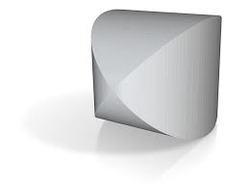An Ancient Chinese Puzzle 2
 This is a follow up problem to
An Ancient Chinese Puzzle
.
This is a follow up problem to
An Ancient Chinese Puzzle
.
Once again, the Mou He Fang Gai is a solid formed by the intersection of two perpendicular cylinders. If the radius of the cylinders is 10 cm, calculate the surface area of the Mou He Fang Gai in square centimetres.
The answer is 1600.
This section requires Javascript.
You are seeing this because something didn't load right. We suggest you, (a) try
refreshing the page, (b) enabling javascript if it is disabled on your browser and,
finally, (c)
loading the
non-javascript version of this page
. We're sorry about the hassle.
3 solutions
Given a cartesian system {x,y,z}, the intersection of the two cylinders of axis (Ox) and (Oz) and radius R is a 3D curve given by the following set of equations:
x ² + y ² = R ²
y ² + z ² = R ²
Using the cylindrical coordinates ( r , t h e t a ) of the (Ox) cylinder
The system becomes:
r ² = R ²
z ² = R ² c o s ² ( t h e t a )
The curve is therefore given by the two parametered curves:
z 1 = R ∣ c o s ( t h e t a ) ∣
z 2 = − R ∣ c o s ( t h e t a ) ∣
Surface lying on the (Ox) cylinder is deduced by integrating ∣ z 1 − z 2 ∣ × R × d ( t h e t a ) over 360°, which gives 8 R ² . Total surface of the object is twice this value (surface on the (Oz) cylinder is egal for symmetryconsiderations).
Hence 1 6 0 0 .
Let the cylinders have the equations x 2 + z 2 ≤ R 2 and y 2 + y 2 ≤ R 2 , respectively. The surface consists of four equal sections.
To find the area of one of these sections, parametrize the surface of the first cylinder as x = R sin θ , z = R cos θ . The intersection with the other cylinder is given by x 2 + z 2 = R 2 y 2 + z 2 ≤ R 2 } ⟹ − R sin θ = − x < y < x = R sin θ . Integrating, we have A = ∫ 0 π ∫ − R sin θ R sin θ R d θ d y = ∫ 0 π ( 2 R 2 sin θ ) = − 2 R 2 cos θ ∣ ∣ 0 π = 4 R 2 . Thus the total area is 4 ⋅ 4 R 2 = 1 6 R 2 = 1 6 0 0 cm 2 .